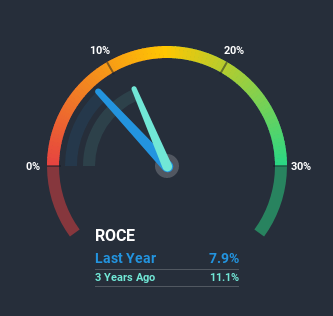The Trends At James Fisher and Sons (LON:FSJ) That You Should Know About
If we want to find a potential multi-bagger, often there are underlying trends that can provide clues. Typically, we'll want to notice a trend of growing return on capital employed (ROCE) and alongside that, an expanding base of capital employed. Put simply, these types of businesses are compounding machines, meaning they are continually reinvesting their earnings at ever-higher rates of return. Although, when we looked at James Fisher and Sons (LON:FSJ), it didn't seem to tick all of these boxes.
What is Return On Capital Employed (ROCE)?
For those that aren't sure what ROCE is, it measures the amount of pre-tax profits a company can generate from the capital employed in its business. To calculate this metric for James Fisher and Sons, this is the formula:
Return on Capital Employed = Earnings Before Interest and Tax (EBIT) ÷ (Total Assets - Current Liabilities)
0.079 = UK£42m ÷ (UK£731m - UK£198m) (Based on the trailing twelve months to June 2020).
Therefore, James Fisher and Sons has an ROCE of 7.9%. In absolute terms, that's a low return, but it's much better than the Infrastructure industry average of 6.2%.
View our latest analysis for James Fisher and Sons
Above you can see how the current ROCE for James Fisher and Sons compares to its prior returns on capital, but there's only so much you can tell from the past. If you're interested, you can view the analysts predictions in our free report on analyst forecasts for the company.
The Trend Of ROCE
In terms of James Fisher and Sons' historical ROCE movements, the trend isn't fantastic. Over the last five years, returns on capital have decreased to 7.9% from 13% five years ago. However it looks like James Fisher and Sons might be reinvesting for long term growth because while capital employed has increased, the company's sales haven't changed much in the last 12 months. It's worth keeping an eye on the company's earnings from here on to see if these investments do end up contributing to the bottom line.
The Key Takeaway
Bringing it all together, while we're somewhat encouraged by James Fisher and Sons' reinvestment in its own business, we're aware that returns are shrinking. And with the stock having returned a mere 2.3% in the last five years to shareholders, you could argue that they're aware of these lackluster trends. Therefore, if you're looking for a multi-bagger, we'd propose looking at other options.
If you want to continue researching James Fisher and Sons, you might be interested to know about the 4 warning signs that our analysis has discovered.
While James Fisher and Sons may not currently earn the highest returns, we've compiled a list of companies that currently earn more than 25% return on equity. Check out this free list here.
This article by Simply Wall St is general in nature. It does not constitute a recommendation to buy or sell any stock, and does not take account of your objectives, or your financial situation. We aim to bring you long-term focused analysis driven by fundamental data. Note that our analysis may not factor in the latest price-sensitive company announcements or qualitative material. Simply Wall St has no position in any stocks mentioned.
Have feedback on this article? Concerned about the content? Get in touch with us directly. Alternatively, email editorial-team (at) simplywallst.com.

